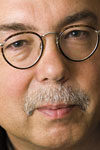|


| |
James Barr
|
The third question in this issue is posed by 34-year-old James Barr, who hopes to become a professional photojournalist very soon.
A graduate in 2006 of the University of Wales, Newport, where he gained a BA Honors degree in Documentary Photography, James has already completed a work placement at The Guardian in London and an internship with The Philippine Daily Inquirer.
Currently James is employed in a steel works in his home town of Sheffield in Northern England, saving up money for his next project.
James says “Very often the best and most interesting pictures are taken in locations which are difficult to access – sometimes for security reasons, sometimes because those locations are dangerous and often just because people would rather keep the whole thing secret.”
He asks, “What's the best way to gain access to take pictures when these difficulties
arise?”
The answer comes from photographer and historian
Jan Banning from Utrecht in the Netherlands.

|
| Jan Banning |
He has wide experience of gaining access in his work, specializing in documentary
photography. Among his publications are books Vietnam. Doi Moi about
Vietnam and Traces of War. Survivors of the Burma and Sumatra Railways
about those who suffered forced labour in Asia in World War Two.
Among his other projects is The Office, focusing on the sold-called
“dynamic” world of bureaucracies.
Says Jan: “It seems to me that there is a big difference between having no access
because of security and because someone wants to keep something secret.
In the case of security, you should certainly try to get a realistic assessment
of the risks involved and of what you can do to minimize those for yourself.
In all cases, begin by trying to find out if anyone else - photographer, radio
or TV journalist, NGO, embassy personnel - has had access and how they managed
it, via whom.
Try to get ‘closer’ to the person who can grant access; find people who know
him. Gather all the information you can about the decision-maker and arrange
a good introduction.
Remember that what may seem impossible at first can sometimes be achieved through
personal contacts. But this differs from country to country.
If you’re not familiar with the country, find out how decisions are made, gauge
the atmosphere and discover the right ‘tone’ in which to approach people.
Once an appointment is made, present a well-chosen selection of photos of comparable
themes you took earlier.
Depending on time, you might consider - in the case of authorities not being
very co-operative – writing a request that is not untrue, but which presents
your plan in a way that might sound acceptable or innocent to the authorities.
Avoid lying but don’t hesitate to embellish and present the truth in the most
favorable light. When writing the letter, keep in mind atmosphere and tone.
Also, try to give them a reason to grant access. Put yourself in their place:
what could, theoretically, be the benefit for the person who decides? Remember,
vanity (theirs) can sometimes be a useful tool.
As for my own project about bureaucracies, much effort goes into obtaining permission.
In each case, I contact colleagues and embassies – again, the approach differs
from place to place.
In Russia and Yemen, I took the official path with a journalists’ accreditation.
In India, I contacted a local scientist, who knew another scientist who knew
the top civil servant of the Public Relations department.
In Bolivia, I came into contact with a nice man from the International Rotary
Club and he had good personal contacts.
So contacts are very important, wherever you are working.
Good luck!”

|
|
